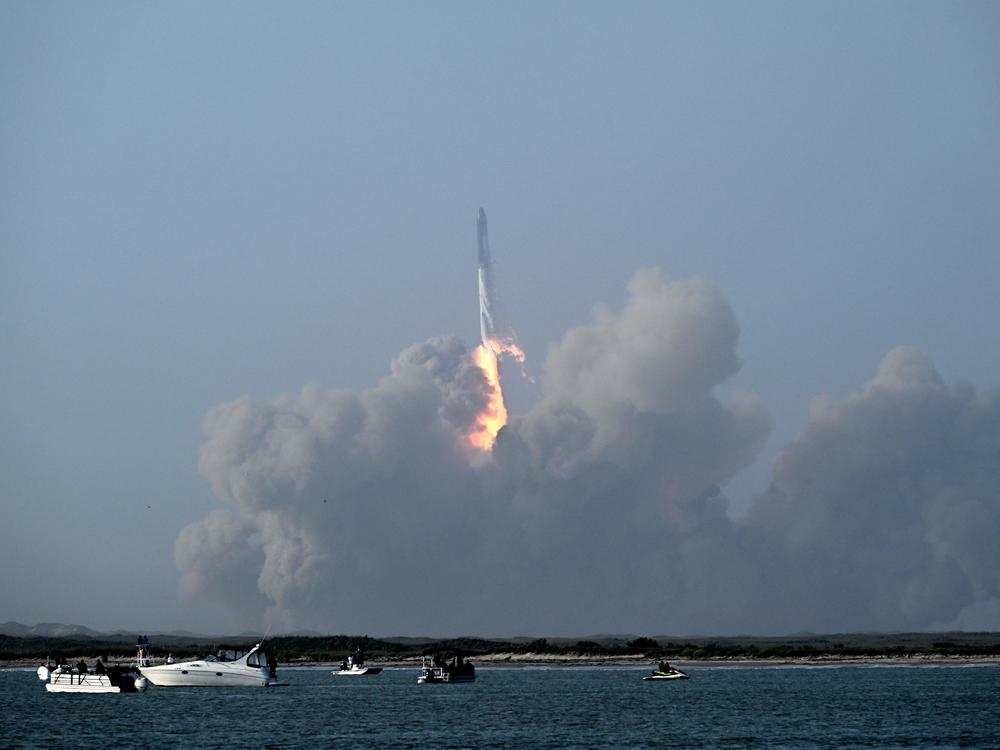Section Branding
Header Content
SpaceX's massive rocket Starship explodes 4 minutes after liftoff
Primary Content
Updated April 20, 2023 at 9:58 AM ET
SpaceX's Starship rocket cleared its launch platform but failed to separate from its booster, exploding four minutes after liftoff during an inaugural test flight on Thursday.
The uncrewed spacecraft, which SpaceX says could one day facilitate multi-planetary life, thundered off the launch pad for what had been expected to be a 90-minute trip around the Earth before a splashdown near Hawaii.
But after reaching MaxQ, the rocket began to spin in the air, then started to plummet before combusting entirely. A livestream of the launch appeared to show some of the 39 engines on the ship had malfunctioned.
"Starship just experienced what we call a rapid, unscheduled disassembly," said John Insprucker, SpaceX's principal integration engineer. "As we said, excitement was guaranteed."
SpaceX staff still cheered as Starship went down in flames. Successfully lifting the 400-foot-tall rocket off the launch pad is still a big step forward to its ultimate goal of one day ferrying humans to the moon and Mars, the company said.
"With a test like this, success comes from what we learn," the company said in a tweet. "Today's test will help us improve Starship's reliability as SpaceX seeks to make life multi-planetary."
The company says it expected the debris to fall somewhere in the Gulf of Mexico, and it'll work with local authorities for recovery operations.
SpaceX CEO Elon Musk says the team will try to test the rocket again in a few months.
A key innovation of Starship is a new engine design called Raptor. It's powerful and may one day be reusable, but SpaceX has seen a few early failures in previous demonstration tests.
A test launch scheduled for Monday was scrapped at the last minute due to a frozen valve in the booster. On Thursday, with 40 seconds left on the countdown clock, the flight crew paused all operations, also due in part to a pressurization issue in the booster.
The decision to use 33 booster engines — more than any other rocket ever made — is a trade-off, says Paulo Lozano, director of MIT's space propulsion laboratory.
Though it's necessary for lifting payloads of up to 250 tons, "having that large number of rocket engines firing simultaneously — it's actually quite hard. I think that's going to be one of the biggest challenges," Lozano said.
Adding to the challenges is the choice of fuel: methane. SpaceX wants to experiment with methane because it's cheaper to produce and easier to handle than hydrogen, the go-to fuel choice for most high-powered rockets.
But to use methane, the rocket's oxidizer oxygen need to be chilled to very low temperatures in order to operate, which is what caused the valve to freeze on Monday.
"It was a great find by the countdown team, and that's why we have a countdown," said SpaceX quality systems engineer Kate Tice at the time. "We've learned a lot over the last 48 hours, and we're ready to give it another go."
SpaceX seems to understand the risks associated with such a monumental test launch. It's blown up quite a few rockets during testing in the past, a development strategy that's worked well in the long-term.
SpaceX is also pinning part of its financial future on this new and fully-reusable orbital system. The company currently uses its Falcon-9 rocket to launch its Starlink Internet satellites into orbit, a few dozen at a time. Starship could one day be able to send several hundred per launch.
Copyright 2023 NPR. To see more, visit https://www.npr.org.


